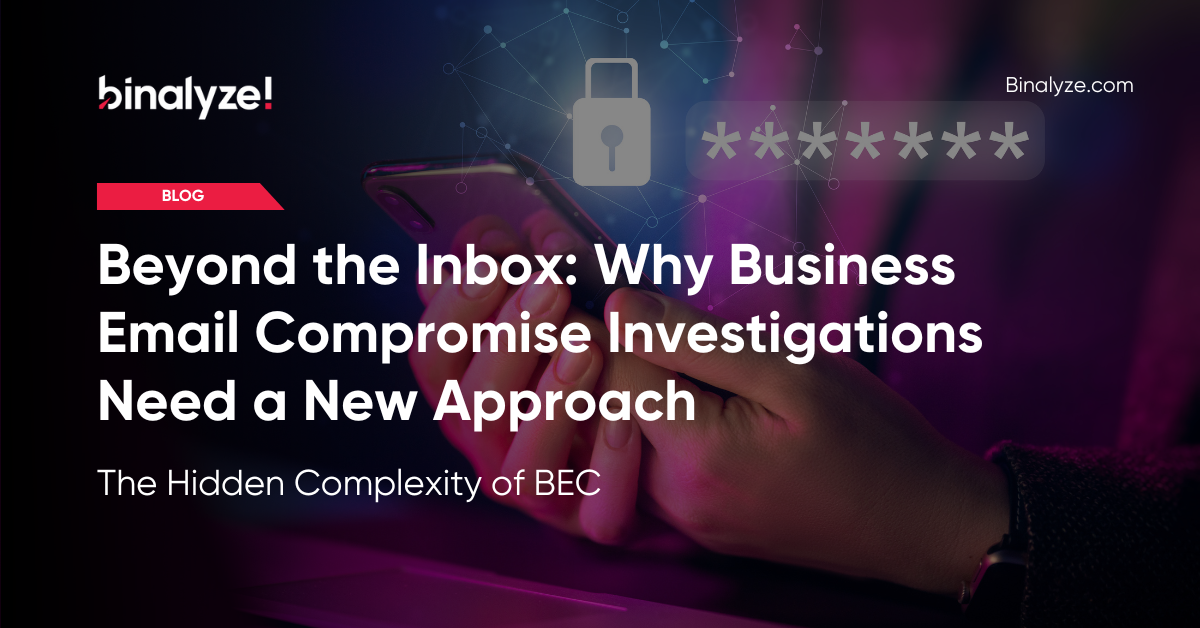2 min read
Why Business Email Compromise Investigations Need a New Approach
![]() Amina Zilic
:
Tue, Mar 18, '25
Amina Zilic
:
Tue, Mar 18, '25

BEC Attacks: Silent But Costly Threat
Business Email Compromise (BEC) remains one of the most financially damaging cyber threats, with global losses exceeding $50 billion over the past decade (FBI IC3, 2023). Unlike traditional phishing attacks, BEC is not about malware—it's about deception, social engineering, and compromised identities. In the security stack, the human element remains the weakest link, as BEC exploits human trust and error rather than technical vulnerabilities, making employees the primary target for social engineering attacks.
Once an attacker gains access to a corporate email account, the real damage unfolds. Fraudulent wire transfers, invoice scams, and data exfiltration can go undetected for weeks or months. By the time an incident is flagged, critical evidence may already be lost.
The challenge? BEC investigations are complex and often focus only on email artifacts—missing the broader forensic footprint of an attack.
The Hidden Complexity of BEC
Most BEC investigations begin - and unfortunately, end in the inbox: analyzing suspicious emails, tracking IP addresses, and resetting credentials.
But, once critical email artifacts are collected (a challenge slowing down timely start of BEC investigations), a complete, conclusive response must go beyond email to uncover:
-
Asset Forensics – What files were accessed, modified, or exfiltrated? Are there signs of deeper intrusion?
-
Persistence Mechanisms – Did the attacker leave backdoors for future access? How long have they maintained access?
-
Lateral Movement – Did the attacker pivot to other systems using stolen credentials? What other assets might be compromised?
The reality is that email logs are just one piece of a much larger puzzle. To see the full picture, security teams need to go beyond the inbox and consider a broader set of forensic evidence. BEC actors often stay hidden for extended periods. Without a holistic view of the attack, security teams won’t understand the full extent of the compromise, and risk missing key indicators—allowing adversaries to return even after remediation.
Expanding the Investigation: Email as Part of a Larger Evidence Set
Once email evidence is collected, investigators must validate and correlate it against other data sources to reconstruct the full chain of events. But this process is often disjointed and time-consuming.
Here’s what happens in most organizations today:
-
Jumping Between Tools – Security teams pull logs from different admin consoles (email, endpoints, cloud apps, SIEMs) and export them into separate files.
-
Manual Correlation – Analysts try to connect timestamps, IPs, and user actions across multiple, isolated datasets—often relying on spreadsheets.
-
Gaps in Visibility – Critical evidence is missed, either because of retention limits, lack of access, or simply getting lost in the noise.
This fragmented approach creates blind spots and delays, making it harder to string together a coherent attack narrative.
The Power of a Consolidated Investigation View
Rather than chasing fragments across multiple platforms, security teams need a centralized case view—where all relevant evidence and findings are brought together in one place.
✔ Seamless Data Correlation – Link email logs with endpoint, cloud, and network activity in a single view.
✔ Reduced Complexity – Eliminate time-consuming, manual workflows across different tools.
✔ Faster, More Confident Response – Move quickly from collection to actionable intelligence.
With a unified investigation workflow, analysts can see the full attack chain in one place, making it easier to track how an attacker moved across systems and what needs to be remediated.
Quickly Integrating Cloud Evidence into Your Investigation Workflow
To help security teams simplify and accelerate their investigation workflow, Binalyze offers a powerful, free Cloud Evidence Collection tool, Binlayze Tornado, that seamlessly integrates into broader forensic investigations.
-
Standalone Use – Collect critical cloud-based artifacts quickly and efficiently, then export to SQLite for further analysis.
-
Integrated with AIR’s Investigation Hub – Send collected cloud data into a unified forensic case view, alongside cross-platfrom forensic evidence and findings from DRONE’s automated analysis, for a more complete investigation workflow.
BEC attacks don’t stop at the inbox—your investigation shouldn’t either.
With Binalyze Tornado, security teams can connect the dots faster, preserve critical forensic evidence, and respond with confidence and speed.










